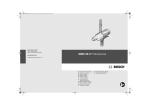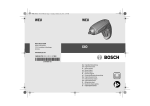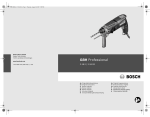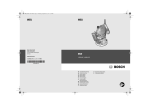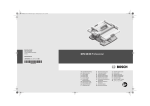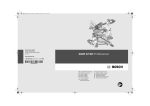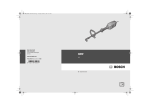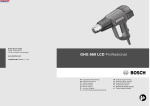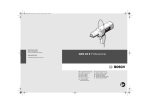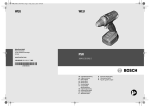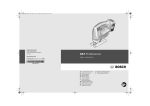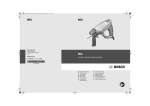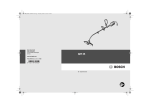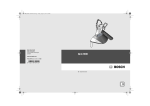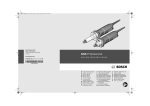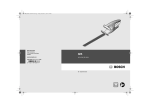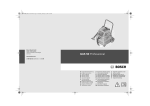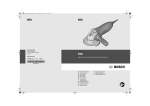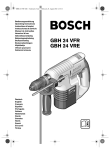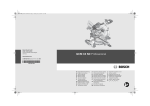Download Bosch GSB 1600RE Hammer Drill User Manual - Tooled
Transcript
OBJ_DOKU-1706-003.fm Page 1 Thursday, June 9, 2011 8:44 AM WEU Robert Bosch GmbH Power Tools Division 70745 Leinfelden-Echterdingen Germany WEU GSB 1600 RE Professional www.bosch-pt.com 1 609 929 M07 (2011.06) PS / 65 WEU de en fr es pt it nl Originalbetriebsanleitung Original instructions Notice originale Manual original Manual original Istruzioni originali Oorspronkelijke gebruiksaanwijzing da sv no fi el tr Original brugsanvisning Bruksanvisning i original Original driftsinstruks Alkuperäiset ohjeet Ðñùôüôõðï ïäçãéþí ÷ñÞóçò Orijinal işletme talimat OBJ_BUCH-99-003.book Page 3 Tuesday, June 7, 2011 12:16 PM 3| 2 608 180 009 (DP 500) 2 608 030 053 (MS 65) 2 608 030 055 (MS 80) 1 612 025 024 2 608 572 105 2 603 001 019 2 607 990 050 (S 41) 2 605 438 607 1 609 929 M07 | (7.6.11) Bosch Power Tools OBJ_BUCH-99-003.book Page 4 Tuesday, June 7, 2011 12:16 PM 4| 4 1 3 5 2 6 98 11 7 10 12 13 5 GSB 1600 RE Professional 12 A B x 3 2 11 10 13 1 609 929 M07 | (7.6.11) 12 Bosch Power Tools OBJ_BUCH-99-003.book Page 5 Tuesday, June 7, 2011 12:16 PM 5| C D 14 15 9 E F 9 16 1 17 G 17 1 609 929 M07 | (7.6.11) 1 16 Bosch Power Tools OBJ_BUCH-99-003.book Page 11 Tuesday, June 7, 2011 12:16 PM English | 11 There is an increased risk of electric shock if your body is earthed or grounded. f Do not expose power tools to rain or wet conditions. Water entering a power tool will increase the risk of electric shock. f Do not abuse the cord. Never use the cord for carrying, pulling or unplugging the power tool. Keep cord away from heat, oil, sharp edges and moving parts. Damaged or entangled cords increase the risk of electric shock. f When operating a power tool outdoors, use an extension cord suitable for outdoor use. Use of a cord suitable for outdoor use reduces the risk of electric shock. f If operating a power tool in a damp location is unavoidable, use a residual current device (RCD) protected supply. Use of an RCD reduces the risk of electric shock. Personal safety f Stay alert, watch what you are doing and use common sense when operating a power tool. Do not use a power tool while you are tired or under the influence of drugs, alcohol or medication. A moment of inattention while operating power tools may result in serious personal injury. f Use personal protective equipment. Always wear eye protection. Protective equipment such as dust mask, non-skid safety shoes, hard hat, or hearing protection used for appropriate conditions will reduce personal injuries. f Prevent unintentional starting. Ensure the switch is in the off-position before connecting to power source and/or battery pack, picking up or carrying the tool. Carrying power tools with your finger on the switch or energising power tools that have the switch on invites accidents. f Remove any adjusting key or wrench before turning the power tool on. A wrench or a key left attached to a rotating part of the power tool may result in personal injury. f Do not overreach. Keep proper footing and balance at all times. This enables better control of the power tool in unexpected situations. f Dress properly. Do not wear loose clothing or jewellery. Keep your hair, clothing and gloves away from moving parts. Loose clothes, jewellery or long hair can be caught in moving parts. f If devices are provided for the connection of dust extraction and collection facilities, ensure these are connected and properly used. Use of dust collection can reduce dust-related hazards. Power tool use and care f Do not force the power tool. Use the correct power tool for your application. The correct power tool will do the job better and safer at the rate for which it was designed. f Do not use the power tool if the switch does not turn it on and off. Any power tool that cannot be controlled with the switch is dangerous and must be repaired. f Disconnect the plug from the power source and/or the battery pack from the power tool before making any adjustments, changing accessories, or storing power Bosch Power Tools tools. Such preventive safety measures reduce the risk of starting the power tool accidentally. f Store idle power tools out of the reach of children and do not allow persons unfamiliar with the power tool or these instructions to operate the power tool. Power tools are dangerous in the hands of untrained users. f Maintain power tools. Check for misalignment or binding of moving parts, breakage of parts and any other condition that may affect the power tool’s operation. If damaged, have the power tool repaired before use. Many accidents are caused by poorly maintained power tools. f Keep cutting tools sharp and clean. Properly maintained cutting tools with sharp cutting edges are less likely to bind and are easier to control. f Use the power tool, accessories and tool bits etc. in accordance with these instructions, taking into account the working conditions and the work to be performed. Use of the power tool for operations different from those intended could result in a hazardous situation. Service f Have your power tool serviced by a qualified repair person using only identical replacement parts. This will ensure that the safety of the power tool is maintained. Safety Warnings for Drills f Wear ear protectors when impact drilling. Exposure to noise can cause hearing loss. f Use auxiliary handle(s), if supplied with the tool. Loss of control can cause personal injury. f Hold the tool by the insulated gripping surfaces when performing operations where the application tool or the screw could contact hidden wiring or its own power cord. Contact with a “live” wire will also make exposed metal parts of the power tool “live” and shock the operator. f Use appropriate detectors to determine if utility lines are hidden in the work area or call the local utility company for assistance. Contact with electric lines can lead to fire and electric shock. Damaging a gas line can lead to explosion. Penetrating a water line causes property damage. f Switch off the power tool immediately when the tool insert jams. Be prepared for high reaction torque that can cause kickback. The tool insert jams when: — the power tool is subject to overload or — it becomes wedged in the workpiece. f When working with the machine, always hold it firmly with both hands and provide for a secure stance. The power tool is guided more secure with both hands. f Secure the workpiece. A workpiece clamped with clamping devices or in a vice is held more secure than by hand. f Always wait until the machine has come to a complete stop before placing it down. The tool insert can jam and lead to loss of control over the power tool. 1 609 929 M07 | (7.6.11) OBJ_BUCH-99-003.book Page 12 Tuesday, June 7, 2011 12:16 PM 12 | English Products sold in GB only: Your product is fitted with a BS 1363/A approved electric plug with internal fuse (ASTA approved to BS 1362). If the plug is not suitable for your socket outlets, it should be cut off and an appropriate plug fitted in its place by an authorised customer service agent. The replacement plug should have the same fuse rating as the original plug. The severed plug must be disposed of to avoid a possible shock hazard and should never be inserted into a mains socket elsewhere. Products sold in AUS and NZ only: Use a residual current device (RCD) with a rated residual current of 30 mA or less. Product Description and Specifications Read all safety warnings and all instructions. Failure to follow the warnings and instructions may result in electric shock, fire and/or serious injury. While reading the operating instructions, unfold the graphics page for the machine and leave it open. Intended Use The machine is intended for impact drilling in brick, concrete and stone as well as for drilling in wood, metal and plastic. Machines with electronic control and right/left rotation are also suitable for screwdriving and thread-cutting. Technical Data Impact Drill Article number Rated power input Output power No-load speed Rated speed Impact rate Rated torque Speed preselection Right/left rotation Spindle collar dia. Max. drilling dia. – Brickwork – Concrete – Steel – Wood Chuck clamping range Weight according to EPTA-Procedure 01/2003 Protection class mm GSB 1600 RE Professional 3 601 B18 1.. 701 351 0–3000 1640 26270 2.0 z z 43 mm mm mm mm mm 18 16 12 30 1.5–13 kg 1.9 /II W W min-1 min-1 min-1 Nm The values given are valid for a nominal voltage [U] of 230 V. For different voltages and models for specific countries, these values can vary. Please observe the article number on the type plate of your machine. The trade names of the individual machines may vary. Product Features Noise/Vibration Information The numbering of the product features refers to the illustration of the machine on the graphics page. 1 Keyless chuck 2 Front sleeve 3 Rear sleeve 4 “Drilling/Impact Drilling” selector switch 5 Handle (insulated gripping surface) 6 Lock-on button for On/Off switch 7 On/Off switch 8 Thumbwheel for speed preselection 9 Rotational direction switch 10 Button for depth stop adjustment 11 Wing bolt for adjustment of auxiliary handle 12 Auxiliary handle (insulated gripping surface)* 13 Depth stop* 14 Universal bit holder* 15 Screwdriver bit* 16 Allen Key** 17 Open-end spanner** Measured sound values determined according to EN 60745. Typically the A-weighted noise levels of the product are: Sound pressure level 98 dB(A); Sound power level 109 dB(A). Uncertainty K =3 dB. Wear hearing protection! Vibration total values ah (triax vector sum) and uncertainty K determined according to EN 60745: Drilling into metal: ah =2.7 m/s2, K=1.5 m/s2, Impact drilling into concrete: ah =23 m/s2, K=3.5 m/s2, Screwdriving without impact: ah <2.5 m/s2, K=1.5 m/s2, Tapping: ah <2.5 m/s2, K=1.5 m/s2. The vibration emission level given in this information sheet has been measured in accordance with a standardised test given in EN 60745 and may be used to compare one tool with another. It may be used for a preliminary assessment of exposure. The declared vibration emission level represents the main applications of the tool. However if the tool is used for different applications, with different accessories or poorly maintained, the vibration emission may differ. This may significantly increase the exposure level over the total working period. An estimation of the level of exposure to vibration should also take into account the times when the tool is switched off or when it is running but not actually doing the job. This may significantly reduce the exposure level over the total working period. Identify additional safety measures to protect the operator *Accessories shown or described are not part of the standard delivery scope of the product. A complete overview of accessories can be found in our accessories program. **Commercially available (not included in the delivery scope) 1 609 929 M07 | (7.6.11) Bosch Power Tools OBJ_BUCH-99-003.book Page 13 Tuesday, June 7, 2011 12:16 PM English | 13 from the effects of vibration such as: maintain the tool and the accessories, keep the hands warm, organisation of work patterns. Declaration of Conformity We declare under our sole responsibility that the product described under “Technical Data” is in conformity with the following standards or standardization documents: EN 60745 according to the provisions of the directives 2004/108/EC, 2006/42/EC. Technical file at: Robert Bosch GmbH, PT/ESC, D-70745 Leinfelden-Echterdingen Dr. Egbert Schneider Dr. Eckerhard Strötgen Senior Vice President Head of Product Engineering Certification Robert Bosch GmbH, Power Tools Division D-70745 Leinfelden-Echterdingen Leinfelden, 09.06.2011 Assembly Screwdriver Tools (see figure C) When working with screwdriver bits 15, a universal bit holder 14 should always be used. Use only screwdriver bits that fit the screw head. For driving screws, always position the “Drilling/Impact Drilling” selector switch 4 to the “Drilling” symbol. Replacing the Drill Chuck f Before any work on the machine itself, pull the mains plug. Removing the Drill Chuck (see figure F) To remove the keyless chuck 1, clamp an Allen key 16 into the keyless chuck 1 and position the open-end wrench 17 (size 12) against the spanner flats of the drive spindle. Place the machine on a firm surface, e.g. a workbench. Hold the open-end wrench 17 firmly and loosen the keyless chuck 1 by turning the Allen key 16 in anticlockwise direction. A tightly sitting keyless chuck is loosened with a light blow onto the long end of the Allen key 16. Remove the Allen key from the keyless chuck and completely unscrew it from the machine. Mounting the Drill Chuck (see figure G) The keyless chuck is mounted in reverse order. The drill chuck must be tightened with a tightening torque of approx. 30–35 Nm. Auxiliary Handle (see figure A) f Operate your machine only with the auxiliary handle 12. The auxiliary handle 12 can be set to any position for a secure and low-fatigue working posture. Turn the wing bolt for adjustment of the auxiliary handle 11 in anticlockwise direction and set the auxiliary handle 12 to the required position. Then tighten the wing bolt 11 again in clockwise direction. Adjusting the Drilling Depth (see figure A) The required drilling depth X can be set with the depth stop 13. Press the button for the depth stop adjustment 10 and insert the depth stop into the auxiliary handle 12. Pull out the depth stop until the distance between the tip of the drill bit and the tip of the depth stop correspond with the desired drilling depth X. Changing the Tool f Before any work on the machine itself, pull the mains plug. Keyless Chuck (see figure B) Hold the rear sleeve 3 of the keyless chuck 1 tight and turn the front sleeve 2 in rotation direction n, until the tool can be inserted. Insert the tool. Hold the rear sleeve 3 of the keyless chuck 1 tight and firmly turn the front sleeve 2 in rotation direction o by hand until the locking action is no longer heard. This automatically locks the drill chuck. The locking is released again to remove the tool when the front sleeve 2 is turned in the opposite direction. Bosch Power Tools Operation Starting Operation f Observe correct mains voltage! The voltage of the power source must agree with the voltage specified on the nameplate of the machine. Power tools marked with 230 V can also be operated with 220 V. Reversing the Rotational Direction (see figures D–E) The rotational direction switch 9 is used to reverse the rotational direction of the machine. However, this is not possible with the On/Off switch 7 actuated. Right Rotation: For drilling and driving in screws, push the rotational direction switch 9 left to the stop. Left Rotation: For loosening and unscrewing screws and nuts, press the rotational direction switch 9 through to the right stop. Setting the Operating Mode Drilling and Screwdriving Set the selector switch 4 to the “Drilling” symbol. Impact Drilling Set the selector switch 4 to the “Impact drilling” symbol. The selector switch 4 engages noticeably and can also be actuated with the machine running. 1 609 929 M07 | (7.6.11) OBJ_BUCH-99-003.book Page 14 Tuesday, June 7, 2011 12:16 PM 14 | English Switching On and Off To start the machine, press the On/Off switch 7 and keep it pressed. To lock the pressed On/Off switch 7, press the lock-on button 6. To switch off the machine, release the On/Off switch 7 or when it is locked with the lock-on button 6, briefly press the On/Off switch 7 and then release it. Adjusting the Speed/Impact Frequency The speed/impact rate of the switched on power tool can be variably adjusted, depending on how far the On/Off switch 7 is pressed. Light pressure on the On/Off switch 7 results in low speed/impact rate. Further pressure on the switch increases the speed/impact rate. Preselecting the Speed/Impact Frequency With the thumbwheel for speed preselection 8, the required speed/impact frequency can be preselected even during operation. The required speed/impact frequency depends on the material and the working conditions, and can be determined through practical testing. Working Advice f Before any work on the machine itself, pull the mains plug. f Apply the power tool to the screw/nut only when it is switched off. Rotating tool inserts can slip off. Tips After longer periods of working at low speed, allow the machine to cool down by running it for approx. 3 minutes at maximum speed with no load. For drilling in tiles, set the selector switch 4 to the “Drilling” symbol. Do not switch over to the symbol “Impact Drilling” or work with impact until after drilling through the tile. Use carbide tipped drill bits when working in concrete, masonry and brick wall. For drilling in metal, use only perfectly sharpened HSS drill bits (HSS=high-speed steel). The appropriate quality is guaranteed by the Bosch accessories program. Twist drills from 2.5–10 mm can easily be sharpened with the drill bit sharpener (see accessories). Maintenance and Service Maintenance and Cleaning f Before any work on the machine itself, pull the mains plug. f For safe and proper working, always keep the machine and ventilation slots clean. If the machine should fail despite the care taken in manufacturing and testing procedures, repair should be carried out by an after-sales service centre for Bosch power tools. 1 609 929 M07 | (7.6.11) In all correspondence and spare parts order, please always include the 10-digit article number given on the type plate of the machine. After-sales Service and Customer Assistance Our after-sales service responds to your questions concerning maintenance and repair of your product as well as spare parts. Exploded views and information on spare parts can also be found under: www.bosch-pt.com Our customer service representatives can answer your questions concerning possible applications and adjustment of products and accessories. Great Britain Robert Bosch Ltd. (B.S.C.) P.O. Box 98 Broadwater Park North Orbital Road Denham Uxbridge UB 9 5HJ Tel. Service: +44 (0844) 736 0109 Fax: +44 (0844) 736 0146 E-Mail: [email protected] Ireland Origo Ltd. Unit 23 Magna Drive Magna Business Park City West Dublin 24 Tel. Service: +353 (01) 4 66 67 00 Fax: +353 (01) 4 66 68 88 Australia, New Zealand and Pacific Islands Robert Bosch Australia Pty. Ltd. Power Tools Locked Bag 66 Clayton South VIC 3169 Customer Contact Center Inside Australia: Phone: +61 (01300) 307 044 Fax: +61 (01300) 307 045 Inside New Zealand: Phone: +64 (0800) 543 353 Fax: +64 (0800) 428 570 Outside AU and NZ: Phone: +61 (03) 9541 5555 www.bosch.com.au Republic of South Africa Customer service Hotline: +27 (011) 6 51 96 00 Gauteng – BSC Service Centre 35 Roper Street, New Centre Johannesburg Tel.: +27 (011) 4 93 93 75 Fax: +27 (011) 4 93 01 26 E-Mail: [email protected] Bosch Power Tools








